Everyone who has experienced interruptions or lack of hot water supply is probably thinking about purchasing a propane tankless water heater. The heating of water in a propane gas unit is performed during its flow through a heat exchanger, which is affected by heat from the burner. While water flows inside the apparatus, its temperature rises, as a result of which hot water comes from the tap almost immediately after turning on the heater. A hydraulic gas burner element is used that regulates the flow of propane, it responds to pressure changes.
The propane tankless hot water heater can be installed outside and inside the house. Normally, the first type is compact and doesn’t have a high GMP level. The second one is able to provide the user with a lot of hot water per minute and the ability to work with a few shower heads, as an example.
If you are looking for a worthy model for your home or suburban housing, take a look at the following heaters which are able to compartmentalize the peculiarities of popular units and demonstrate their strengths and weaknesses.
Propane Tankless Water Heater Reviews
Rinnai RL Series HE
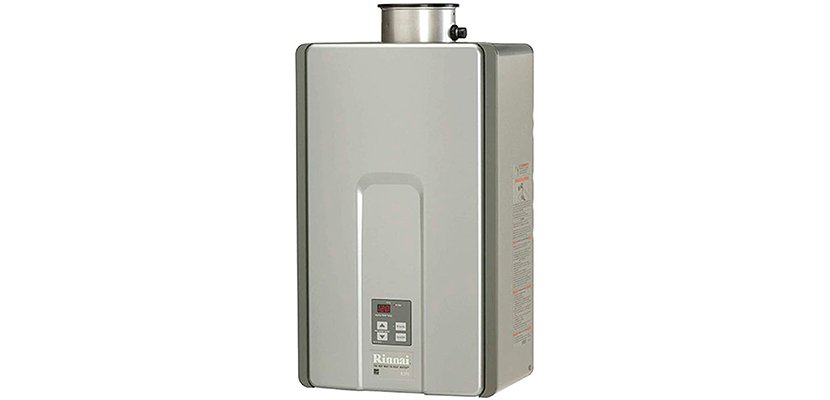
Such a tankless propane water heater produces 9.5 GPM hot water flow that is enough for usage in two baths, kitchen, and even laundry room. This Rinnai propane tankless water heater is fully adapted to work in different conditions, as it has minimal requirements for gas and water pressure. It has a classic design (silver-color body frame) and compact dimensions (9.6 x 14 x 24.3 inches). This is a good solution to the problems with hot water for a standard apartment or a small house. Its capacity is quite enough for a family of 3-4 members. Pay attention that this outdoor propane tankless water heater has weather protection and uses 40% less energy in comparison with the traditional tanks. It’s suitable for residential and commercial installation. In the first case, the unit can produce the water, the temperature of which varies between 98°F and 140°F, while in the second – 98°F – 185°F. The warranty terms are rather impressive, as residential one lasts 10 years (heat exchanger), 1 year (labor), 5 years (parts). Despite the information that it won’t work properly with low water pressure, the unit greatly performs its main tasks even with 45 – 55 PSI pressure level.
Pros
- There’s a specific Circ-Logic technology that defines recirculation patterns and resembles the user’s preferences.
- The manufacturer reports about the long average life expectancy (nearly 20 years).
- In a case of some problems appearing, you can see the error number on the screen and look for its solution in the manual.
Cons
- It takes a few minutes of waiting to get the hot water.
- Flow rate changes depending on the outside weather.
Rinnai V Series HE
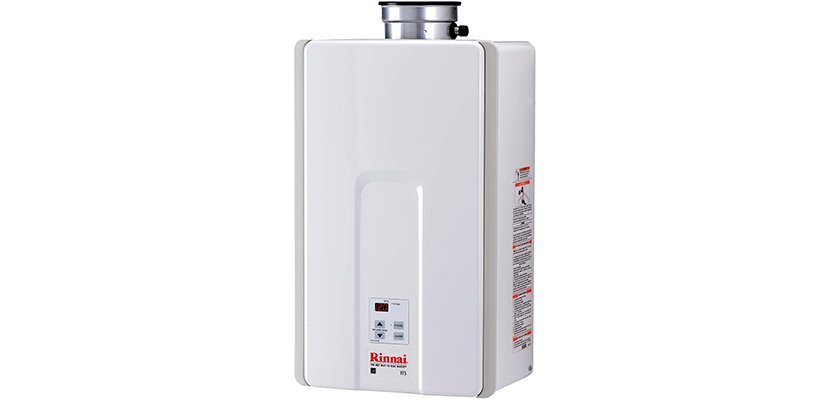
This indoor propane tankless water heater is able to produce nearly 7.5 GPM that’s enough to provide with hot water 4 fixtures (3 – 4 rooms). It’s a good choice for small houses, as its body frame is relatively compact (14 x 9 x 23 inches) and has the unshowy silver coloring, that won’t spoil most of the interiors. The unit is Wi-Fi compatible and can be managed via Control-R 2.0 mobile app. Such a solution enables the possibility to control the heater even from another part of the house. The tankless water heater with propane is enriched by a concentric venting system that allows the intake and exhaust vent to pass through the sidewall or even roof. I really like the temperature lock, as such a feature prevents circumstantial and unexpected changes in the water temperature (the normal range is 98°F – 140°F). The warranty period is standard for Rinnai products: 10 years (heat exchanger), 1 year (labor), and 5 years (parts). Pay attention that the heater works seamlessly when the water pressure level is at least 50 PSI (the Rinnai recommends 60-80 PSI for getting the maximum performance).
Pros
- There’s a leak detection that stops the water supply in the case of an emergency.
- The enhanced scale detection reduces the possibility to get serious heater damages.
- It has a recirculation technology that brings the possibility to deliver the hot water in a few seconds (unlike many other models, which deliver water in a minute).
Cons
- The installation process is accompanied by a special double insulated piping. Therefore, outdoor insulation has to be performed on a compulsory basis.
- The heater doesn’t come with tools that are required for a successful installation. You have to purchase them additionally or call a specialist.
Gasland Outdoors BS158
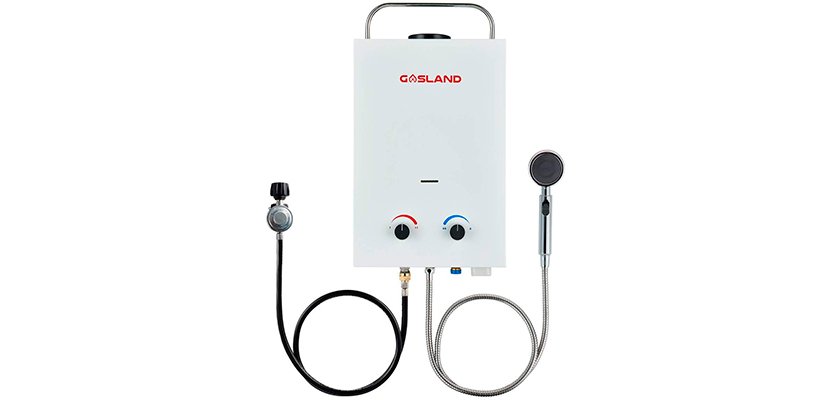
The Gasland propane gas tankless water heater is made for outdoor installation and produces 1.58 GPM of hot water, so it can be used only for no more than two rooms. Its compact size (11.8 x 6.1 x 17.3 inches) is suitable for installation anywhere, as the body frame material is protected from the harmful humidity influence. It is provided with flame failure and overheating protection. That’s important that the manufacturer complemented the product with the anti-freezing drain plug. I can discharge the remained water with such a plug in order to avoid freezing while it is not in use for a long time. The Gasland Outdoors BS158 has a combustion technology, due to which I don’t hear the burning noise even standing next to the device. The minimum level of allowed water pressure is only 2.5 PSI and this indicator can reach the 110 PSI. Perhaps, some people may perceive the Gasland product as the best propane tankless water heater, but the manufacturer proposes only a 1-year warranty, that is hard to call a good addition.
Pros
- When the temperature reaches 167°F, the system automatically shuts off and stops the propane supply.
- It’s easy to install it manually. You just have to follow the recommendations in instruction.
- You can easily hang it anywhere via the mounting bracket (it’s located on top/back of the heater).
Cons
- The adaptor for hooking the garden hose (it comes with the tankless propane hot water heater) doesn’t swivel.
- The knobs on the body frame swing tightly and only after the force applying.
Camplux 1.32 GPM
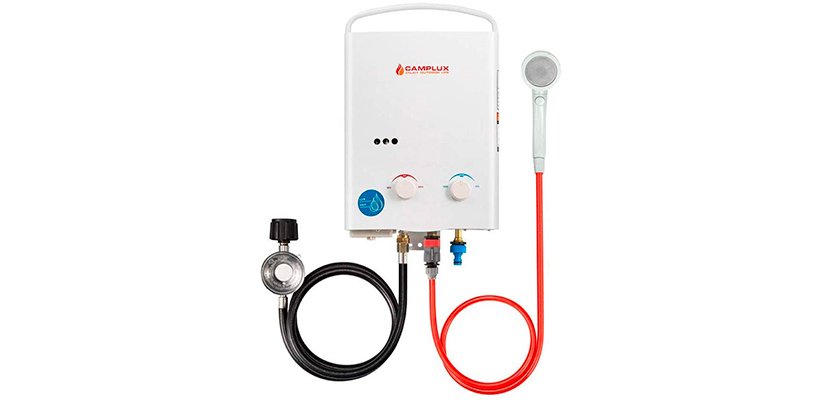
This tankless hot water heater with propane requires low water pressure (3 PSI) for normal functioning (the maximum indicator is 110 PSI) and is ready to provide the user with 1.32 GPM. It can seamlessly work even with Camplux 12V 1.2 GPM water pump. It’s worth noting that the unit is compact (11.4 x 4.3 x 14.8 inches) and is recommended to be installed outdoors. The indoor location is also possible but only in the case of the flue pipe or duct presence and satisfactory ventilation in the room creating. Consider, that even in a case of indoor installation, the heater will be able to warm up water for a few rooms. It is powered by two lithium batteries, the average life of which is 180 days (it’s a good indicator), so it’s an impressive choice for camping and family vacation. It’s really sad that batteries are not included in the propane tankless water heater and have to be purchased additionally. The heater comes with the shower head and hose. The Camplux product also can run on electricity but such mobility is an unconditional bonus. Pay attention that the minimum temperature water is 46.4℉, while the maximum – 114.8℉. The product comes only with a 1-year warranty.
Pros
- Oxygen depletion protective element is included in the heater and allows enjoying the warm shower outdoors.
- The device has an anti-freezing protection and it will signal to the user in a case flame failure.
Cons
- It doesn’t work properly after elevation above 2000ft, so it’s not the solid variant for extreme tours.
- The device has a white body frame that is rather easily soiled. All the spots and small scratches are greatly visible on it.
Rinnai RUC98iP
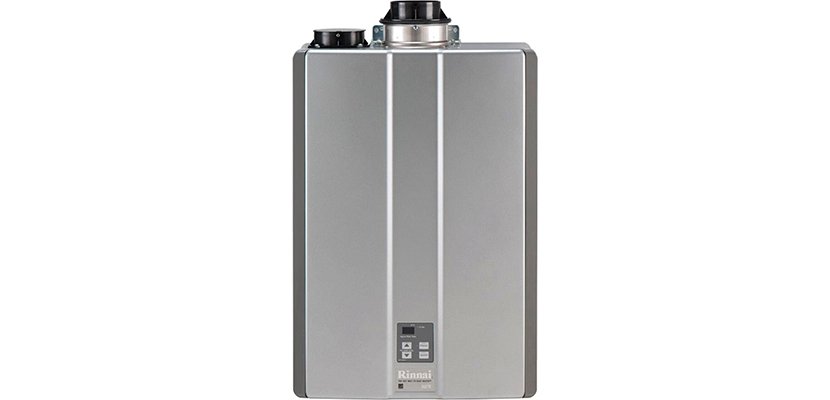
The Rinnai RUC98iP has a maximum of 9.8 GPM and that’s enough for providing nearly 5 rooms with hot water. This device is for indoor installation only and can be placed anywhere in the house as its dimensions are only 10 x 18.5 x 26 inches. Its body frame has temperature control buttons and a digital screen, where the user can see the error number and find information about it in the manual. The unit has a silver-color body frame, so the dust and small scratches are not visible on it (comparing with the white one). The maximum water temperature level in living houses can reach 140°F, while in commercial buildings – 185°F. It requires at least 50 PSI to run this unit. Special advanced technology guarantees really low CO2 emissions and low noise level. Maybe, the RUC98iP isn’t the best tankless propane water heater, but you can improve its length of experience via the filtration system installation that reduces the scale formation. Its residential warranty on the heat exchanger is 12 years, while commercial – 5 years.
Pros
- The valves come with the heater that helps save your money.
- There are 2 built-in heat exchangers, which raise the tankless unit efficiency.
- The shower on the second floor heats up about 30 seconds, that’s a good result.
Cons
- If you are using the concentric vent pipe, the one exhaust pipe is required. It has to be used while installation and needs to be purchased separately.
- The figures, displayed on the front display are small and faded, so it’s hard to see the information correctly.
Foruee Portable 1.32GPM
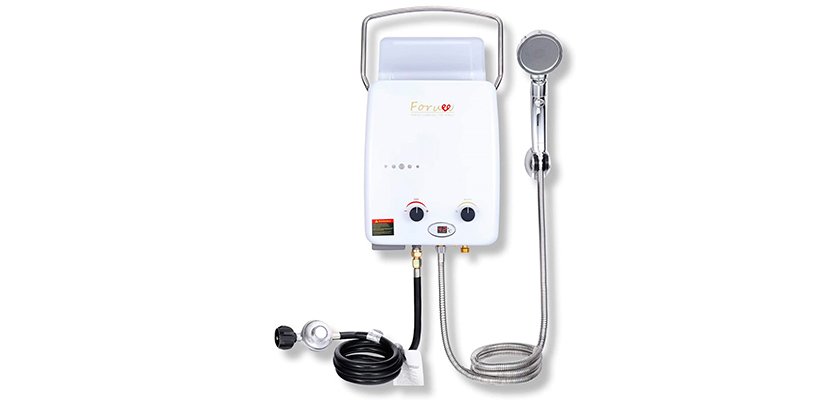
This propane tankless water heater can be perceived as a decent outdoor solution, as it produces 1.32 GPM that’s enough for 1-2 shower takings. It’s better to use this unit with one source at a time. This unit comes with the long (59 inches) hose made of stainless steel that’s enough for most basic operations and the proper shower head. Its white body frame is relatively compact (11.5 x 4.7 x 13.4 inches) and has smoothed corners. The minimum water level pressure is 2.5 PSI that’s a common indicator and makes it easy to use the facility in the open air. Note that when the minimum flow is 0.5 GPM, the water temperature may be heated up to 102°F, while when reaching the max flow, its temperature can be 38°F. Perhaps, this unit isn’t the best propane tankless water heater, but I really like that no electricity needed for its functioning and its basic power source is the batteries. The manufacturer proposes a 1-year warranty after purchasing and a lifetime after-sales service.
Pros
- It’s easy to drain the unit via the drainage device.
- The heater can be installed permanently outdoors (the heavy rain and other weather conditions won’t damage it).
Cons
- The batteries that are required for seamless working are not included.
- One of the rivets that holds the handle is cracked.
Buyer’s Guide
Propane Tankless Water Heater: Basic Factors Before Purchasing
How Much Propane Does a Tankless Water Heater Use?
Pay attention that propane emits 60% less greenhouse gas, compared with the regular gas. Moreover, regular gas burns a lot but creates less heat. Nearly 1 gallon of propane is enough to replace 3-4 gallons of the abovementioned gas (if take into account the necessity to heat up the same water volume). It’s not easy to calculate the amount of propane, burned to produce 1 gallon of water as burning or energy production greatly depends on the geographical location and the atmospheric temperature. The water hardness also influences, as the user has to take care of the water softener usage (in such a case the amount of burned propane increases). Some propane tankless hot water heaters manufacturers indicate the recommended temperature of use, so before buying you need to examine the available information in more detail. Moreover, certain models are able to produce 5 gallons per minute, while others can even reach 9 gallons per minute and such a peculiarity influences propane consumption.
Let’s get acquainted with the situation in the US region. The 15 gallons of propane may be enough for a family of 2 persons, while a big family of 3 – 4 persons will use nearly 25 gallons of propane each month. In a case of 5 persons living in one house, 35 – 40 gallons of fuel may be required. After familiarizing with the approximate volumes of propane usage, you can draw small conclusions in terms of finances. 1 gallon of propane costs $2.20, so a family of 2 members will spend nearly $33 monthly, 3 – 4 persons – $55, and 5 residents – approximately $88.
Temperature
It’s important to know and estimate the moderate temperature in urban regions. Don’t forget to take into account the maximum temperature that is required. Usually, most propane tankless water heaters are able to reach 140°F, but this index may be lower in cold areas. One more reason that influences the water temperature fluctuations is a low pressure. The main gas burner can become automatically disable in a case of lowering the water flow in the tankless propane water heater (the reason is the flow activation rate deepen below). It’s important to check the manual and find the minimum required flow rate in order not to get into such a situation.
There are other problems that may cause water pressure fickleness:
- The incorrectly designed heating systems;
- Frequent flushing of the toilet(s) in the building;/li>
- The fact that additional fixtures in the house are opened and closed.
Restrictions on the flow of hot water in the shower heads also may be regarded as a reason. You should check plumbing fixtures and faucet aerators for mineral deposits (which may cause some clogging). The above-mentioned elements should be flushed (vinegar can help, but it’s important not to forget to rinse them with water) or replaced in a case of need. Some new heaters are complemented with the flow control knobs, which manage the unit’s activation rate. After adjusting at the lowest level, the water temperature will rise.
Dirty inlet filter screen may also influence the water flow and temperature, so it’s better to remove it and clean up. If such a process is useless or impossible (due to the defective condition), it’s better to replace the filter. Plumbing problems (failed washers or faulty mixing valves) are regarded as one of the most widespread roots of the problem, so you should carefully check the plumbing correctness.
Water Flow Rates
Such a rate can be calculated after composing the GPM for the common water fixtures that are widely used for one time.
- A bathroom faucet – 0.5 – 1.5 GPM;
- A kitchen faucet – 3.0 – 7.0 GPM;/li>
- A shower faucet – 1.0 – 2.0 GPM.
Pay attention that if the hot water doesn’t quickly enough reach the faucet, you can complement the heat source with the circulation system. It all depends on the chosen tankless heater model, as some of them have the construction peculiarities for circulation system add-on. As a result, you don’t have to reconfigure the buffer tank or piping.
Safety
After some propane tankless water heater review analyzing, it’s easy to see that some modern propane tankless heaters have self-protection system. It stops the unit’s functioning in a case of unacceptable terms of exploitation or some problems in the system. This refers to gas shortages, technical malfunctions, or working in extremely cold conditions. Moreover, sometimes the manufacturers add to their products the freezing protection that is very useful during the cold winter months.
Don’t forget to be careful with the gas usage, as the propane has relatively high density, is able to settle on the floor, and can be placed on the lowest point of the apartment. It’s better to install the gas detector that performs the monitoring via the cyclical measuring the concentration of propane in ambient air. In case of exceeding the permissible norm (the data will be displayed on the detector display), an optical and sound alarm occurs.

